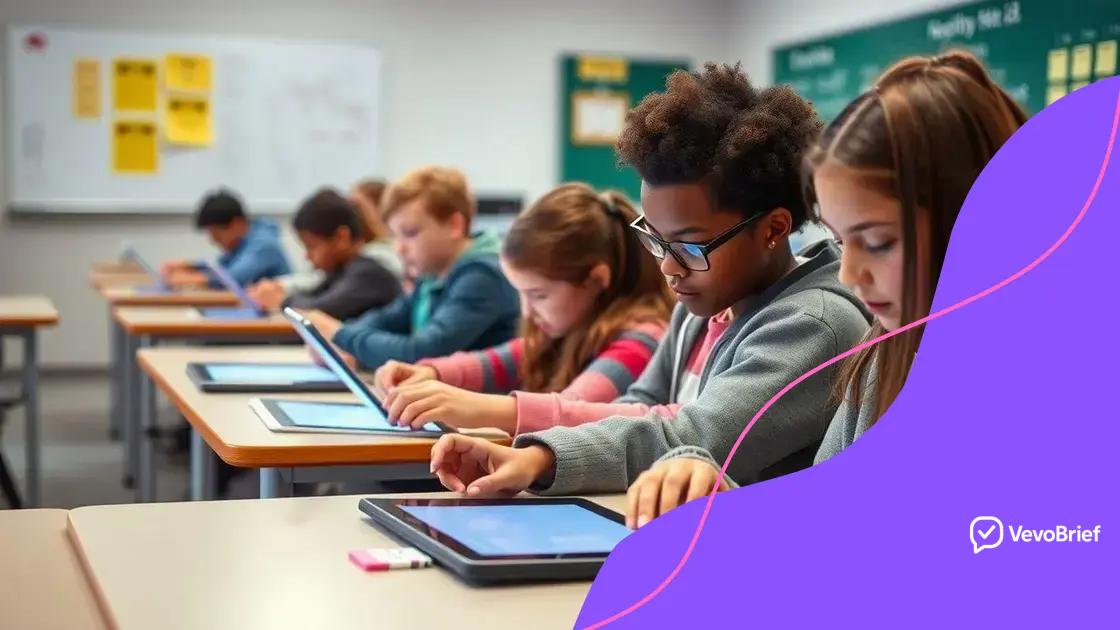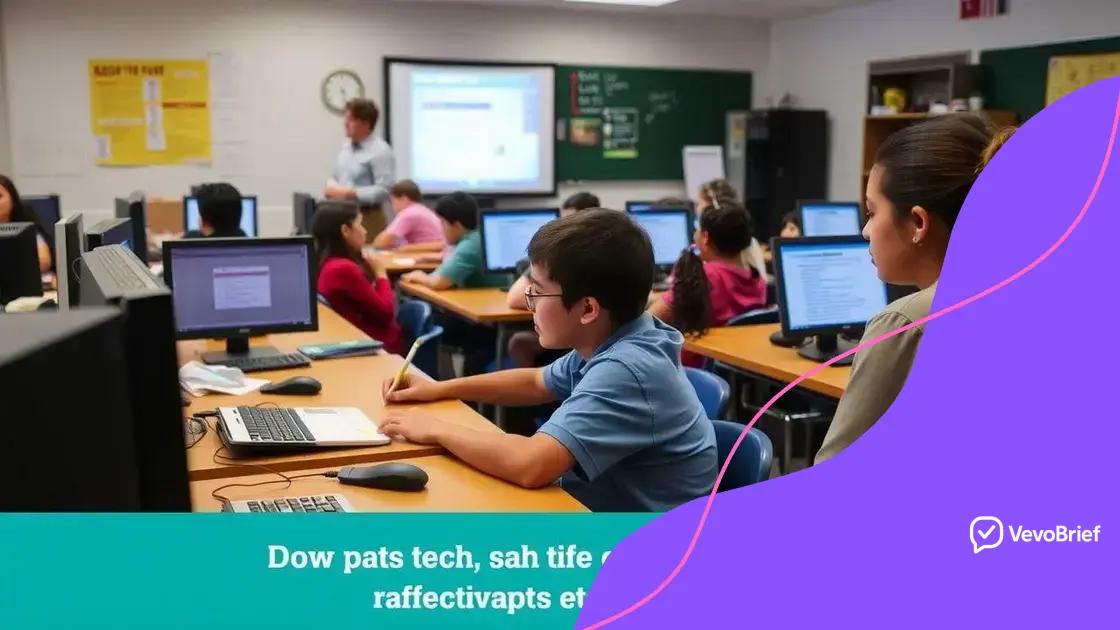Technology’s role in standardized testing sparked debate

Technology’s role in standardized testing evolves with adaptive assessments, AI integration, and increased accessibility, while also facing challenges like equity and infrastructure requirements.
Technology’s role in standardized testing is often at the forefront of discussions about educational equity. Have you ever wondered how tech advancements change the way students are assessed? Let’s dive into this intriguing subject.
Understanding standardized testing and its evolution
The evolution of standardized testing is a significant topic that reflects the changing landscape of education. Understanding standardized testing helps us see how assessments have transformed over time and what that means for students today.
Historical Context of Standardized Testing
Standardized tests have been used for many years. They were first designed to measure student performance and compare educational outcomes. Originally, these tests aimed to ensure a minimum level of competency among students.
Changes in Testing Methods
As time progressed, the methods for administering tests have also evolved. With the introduction of technology, we now have computerized assessments that offer immediate feedback. This shift has made testing more accessible for many students.
- Computer-based assessments provide faster scoring.
- They can offer a wider array of question types.
- Tech innovations can lead to more engaging formats for students.
Moreover, embracing technology allows for a more personalized testing experience. Teachers can adapt assessments to better suit individual learning needs, ensuring that every student has a chance to succeed.
The Current Debate
Despite advancements, there is ongoing debate about the effectiveness of standardized tests. Critics argue that these tests do not always accurately reflect a student’s capabilities. They tend to focus on memorization rather than critical thinking skills.
On the other hand, supporters claim that standardized testing provides a uniform measure of student achievement. It allows schools to gauge performance and identify areas for improvement.
- Standardized tests can highlight educational disparities.
- They help in evaluating educational programs.
- Tests can often be used for college admissions.
As we look to the future, the role of standardized testing will likely continue to change. New technologies will play a critical role in shaping how we assess knowledge and skills. Understanding standardized testing and its evolution is vital for educators, parents, and students alike.
The impact of technology on testing accessibility
The impact of technology on testing accessibility is profound and transformative. With advancements in digital tools, students from various backgrounds now have better opportunities to showcase their abilities.Technology has made it easier for many students, including those with disabilities, to participate in standardized testing.
Enhanced Accessibility Features
Modern standardized tests often include features that cater to diverse learners. For instance, screen readers and audio instructions help students with visual impairments. Similarly, adjustable font sizes and color contrast settings allow learners to customize their testing experience.
Remote Testing Opportunities
Another significant advancement is remote testing. Students can take tests at home, making standardized assessments more accessible for those who may face barriers at traditional testing centers. This change is especially beneficial for individuals with health concerns or transportation issues.
- Remote testing reduces anxiety for many students.
- It allows for a comfortable testing environment.
- Students can use their own devices, which they are familiar with.
Furthermore, technology facilitates the creation of personalized testing experiences. Adaptive assessments adjust difficulty based on student responses, ensuring that tests measure what a student knows realistically. This approach helps to reduce frustration and accurately assess a student’s abilities.
The Role of Data Analytics
Additionally, data analytics in educational technology enables educators to identify patterns in student performance. This information can help schools address gaps in student achievement, ensuring that all learners receive the support they need. Analyzing data helps tailor interventions to improve accessibility and outcomes for diverse populations.
Overall, the evolution of technology is reshaping the landscape of testing accessibility. With these advancements, more students can demonstrate their knowledge in ways that reflect their true capabilities.
Debating the effectiveness of tech-based assessments

Debating the effectiveness of tech-based assessments is crucial as education continues to evolve with technology. These assessments offer benefits but also raise important questions about their real impact on learning outcomes.
Advantages of Tech-Based Assessments
Proponents of tech-based assessments argue that they provide immediate feedback. This feature allows students to understand their strengths and weaknesses right after completing a test. Moreover, technology can customize assessments to better fit a student’s learning style.
Potential Drawbacks
However, critics point out several drawbacks. For one, not all students have equal access to technology. This digital divide can widen existing educational disparities. Additionally, some worry that relying heavily on technology can lead to a focus on rote memorization instead of deeper understanding.
- Some students may struggle with the technology itself.
- Tech-based assessments can encourage test-taking fatigue.
- There is a risk of overemphasis on standardized formats.
Furthermore, the security and integrity of online assessments can be questioned. Issues like cheating and data privacy arise with increased reliance on technology. Schools must ensure that their systems are secure and fair for all students.
Striking a Balance
The debate around tech-based assessments is not black and white. Finding a balance between traditional and tech-based methods may be the key to effective evaluation. Blended approaches could allow for flexibility in assessing a diverse student population.
Ultimately, ongoing discussions will determine how effective tech-based assessments can be integrated into educational systems. By weighing the pros and cons, educators can create better testing experiences for all students.
Challenges in implementing technology in testing
Challenges in implementing technology in testing can impact the effectiveness of educational assessments. While technology provides many benefits, it also introduces various hurdles that schools must navigate.
Infrastructure Issues
One major challenge is the need for proper infrastructure. Many schools, especially in underfunded areas, lack the necessary hardware and reliable internet access. Without these resources, effective implementation of tech-based testing becomes nearly impossible.
Training for Educators
Another significant hurdle is ensuring that educators are trained to use new technologies effectively. Even with the best tools available, if teachers are not equipped to integrate them into their teaching, the benefits of technology cannot be fully realized.
- Professional development is often needed for effective use of tech tools.
- Teachers should feel confident in handling tech-related issues.
- Time is needed for training without disrupting classroom schedules.
Moreover, there are concerns about the reliability and security of online assessments. Issues such as technical glitches during testing can lead to frustration and mistrust among students and educators alike. Schools must invest in robust systems that minimize potential problems during assessments.
Equity Considerations
Equity is another challenge. Not all students have equal access to the devices or internet connectivity they need to take tech-based tests. This disparity can lead to unequal testing conditions, further widening the achievement gap among students.
In addition, some students may struggle with the format of digital assessments. Familiarity with technology varies widely, and educators must ensure that all students receive the necessary support to perform to the best of their abilities.
Overall, while there are many challenges in implementing technology in testing, addressing these obstacles can lead to more effective assessment methods in education.
Future trends in standardized testing technology
Future trends in standardized testing technology are set to reshape the landscape of education assessment. As technology continues to advance, it opens up exciting possibilities for how tests are designed and administered.
Adaptive Testing
One significant trend is the rise of adaptive testing. These assessments adjust in real-time to the student’s performance, offering questions that are matched to their skill level. This method ensures that each student is challenged appropriately, making assessments more personalized.
Use of Artificial Intelligence
Another exciting development is the integration of artificial intelligence (AI) in testing. AI can analyze student responses to identify patterns and provide tailored recommendations for improvement. This technology holds the potential to customize learning experiences based on individual student needs.
- AI can help educators monitor student progress more efficiently.
- Intelligent systems can create targeted study plans.
- Machine learning can improve future assessments based on past results.
Furthermore, the increasing use of data analytics will enhance how schools evaluate student performance. With advanced data collection methods, educators can gain valuable insights into student learning habits and challenges. This information can inform instructional strategies and help close learning gaps.
Virtual Reality Assessments
Innovative technologies like virtual reality (VR) may also play a role in future testing. VR can create immersive environments where students can demonstrate knowledge in real-world scenarios. This method could lead to more engaging and practical assessments.
As remote learning continues to be a viable option, we may see further improvements in security and accessibility in online assessments. These innovations aim to ensure that all students can take tests fairly, regardless of their location.
The evolution of standardized testing technology is crucial for accommodating the changing needs of education. By embracing these trends, educators can enhance the assessment experience for every learner.
In conclusion, the advancements in technology have greatly influenced standardized testing. With the rise of adaptive assessments and AI integration, tests are becoming more personalized and efficient. However, challenges remain, such as addressing equity and ensuring access to technology for all students. As we move forward, embracing these innovations will be essential for creating fair and effective assessment methods. The future of standardized testing holds promise, and it is crucial to continue evolving these practices to meet the needs of all learners.
\n\n
\n
FAQ – Frequently Asked Questions about Technology in Standardized Testing
What is adaptive testing?
Adaptive testing is a method where the test adjusts in real-time based on student performance, providing customized questions that match their skill levels.
How does AI enhance standardized assessments?
AI analyzes student data to improve test design and offers personalized recommendations for learning, helping students focus on areas they need to improve.
What challenges might schools face with tech-based assessments?
Schools may struggle with infrastructure issues, training educators, and ensuring equitable access to technology for all students.
What are future trends in standardized testing technology?
Future trends include the use of virtual reality for immersive assessments, more data analytics for informed decision-making, and improved security measures for online tests.
